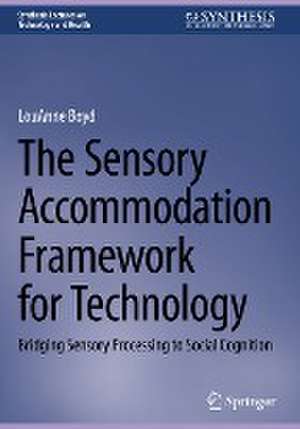The Sensory Accommodation Framework for Technology: Bridging Sensory Processing to Social Cognition: Synthesis Lectures on Technology and Health
Autor LouAnne Boyden Limba Engleză Hardback – 3 ian 2024
Din seria Synthesis Lectures on Technology and Health
-
 Preț: 392.60 lei
Preț: 392.60 lei -
 Preț: 318.07 lei
Preț: 318.07 lei - 20%
 Preț: 296.34 lei
Preț: 296.34 lei - 20%
 Preț: 419.25 lei
Preț: 419.25 lei - 20%
 Preț: 223.34 lei
Preț: 223.34 lei - 20%
 Preț: 331.08 lei
Preț: 331.08 lei - 20%
 Preț: 300.66 lei
Preț: 300.66 lei - 20%
 Preț: 226.64 lei
Preț: 226.64 lei - 20%
 Preț: 326.13 lei
Preț: 326.13 lei - 20%
 Preț: 390.32 lei
Preț: 390.32 lei - 20%
 Preț: 326.97 lei
Preț: 326.97 lei - 20%
 Preț: 358.04 lei
Preț: 358.04 lei - 20%
 Preț: 328.60 lei
Preț: 328.60 lei - 20%
 Preț: 329.76 lei
Preț: 329.76 lei - 20%
 Preț: 298.64 lei
Preț: 298.64 lei - 20%
 Preț: 228.80 lei
Preț: 228.80 lei - 20%
 Preț: 269.03 lei
Preț: 269.03 lei - 20%
 Preț: 270.04 lei
Preț: 270.04 lei - 20%
 Preț: 329.26 lei
Preț: 329.26 lei
Preț: 246.51 lei
Preț vechi: 308.13 lei
-20% Nou
Puncte Express: 370
Preț estimativ în valută:
47.17€ • 49.38$ • 39.03£
47.17€ • 49.38$ • 39.03£
Carte tipărită la comandă
Livrare economică 01-07 aprilie
Preluare comenzi: 021 569.72.76
Specificații
ISBN-13: 9783031488429
ISBN-10: 3031488423
Pagini: 124
Ilustrații: XII, 124 p. 36 illus., 32 illus. in color.
Dimensiuni: 168 x 240 mm
Greutate: 0.43 kg
Ediția:1st ed. 2024
Editura: Springer Nature Switzerland
Colecția Springer
Seria Synthesis Lectures on Technology and Health
Locul publicării:Cham, Switzerland
ISBN-10: 3031488423
Pagini: 124
Ilustrații: XII, 124 p. 36 illus., 32 illus. in color.
Dimensiuni: 168 x 240 mm
Greutate: 0.43 kg
Ediția:1st ed. 2024
Editura: Springer Nature Switzerland
Colecția Springer
Seria Synthesis Lectures on Technology and Health
Locul publicării:Cham, Switzerland
Cuprins
Chapter 1: Introduction to Autism for Assistive Technologists.- Chapter 2: Technologies Across the Disciplines for Autistic Users.- Chapter 3: Sensory Processing in Autism.- Chapter 4: Designing Sensory Environments and Sensory Interactions in Virtual Reality.- Chapter 5: The Hierarchy of Visual Attention in Natural Scenes.- Chapter 6: From Sensory Perception to Realtime NonVerbal Communication.- Chapter 7: Timing is Everything: Temporal Processing and MultiSensory Integration.- Chapter 8: Neuro-Inclusive Design Considerations for Assistive and Accessible Technologies and Beyond.
Notă biografică
Dr. LouAnne Boyd is an Assistant Professor of Computer Science at Chapman University, Her research interests center around the design, development, and evaluation of novel technologies to support neurodiverse populations. Her current projects investigate the efficacy of a new interaction design framework drawn from neuroscience theories to accommodation sensory processing impairments. Specific projects under investigation include the development of technologies to increase the accessibility of information for people with autism, ADHD, anxiety, bipolar, or dyslexia.
Textul de pe ultima copertă
This book provides a thorough introduction to the many facets of designing technologies for autism, with a particular focus on optimizing visual attention frameworks. This book is designed to provide a detailed overview of several aspects of technology for autism. Each Chapter illustrates different parts of the Sensory Accommodation Framework and provides examples of relevant available technologies. The books first discusses a variety of skills that make up human development as well as a history of autism as a diagnosis and the birth of the neurodiversity movement. It goes on to detail individual types of therapy and how they interact with autism. The systems involved in sensory processing and their specific relation to autism are then explored, including through technologies that have addressed these areas and applications for designers. Readers will learn about designing sensory environments and sensory interactions, such as through virtual reality. This book places a needed emphasis on the hierarchy of information in technology development by exploring visual attention in neurodivergent conditions like autism, ADHD, and dyslexia. It also delves into the relationship between sensory perception and nonverbal communication, the bridge between sensory input and social behavior, and dynamic information. The discussion is rounded out with examinations of temporal processing as and multisensory integration as complicating factors that have existing technological solutions. Finally, the book closes with a summary of the sensory accommodation framework in respect to how each layer offers different user experience goals and specific mechanisms to promote those goals. Readers from a variety of research backgrounds will find this book informative and useful, while designers will learn essential skills for effectively designing autism technologies.
- Explores visual attention and other sensory-based approaches to designing effective technologies for autism
- Emphasizes the unique perceptual considerations for neurodiverse users of assistive technologies
- Suggests an alternative, interdisciplinary and user-centered approach to designing technologies for autism
Caracteristici
Explores visual attention and other sensory-based approaches to designing effective technologies for autism Emphasizes the unique perceptual considerations for neurodiverse users of assistive technologies Suggests an alternative, interdisciplinary and user-centered approach to designing technologies for autism
